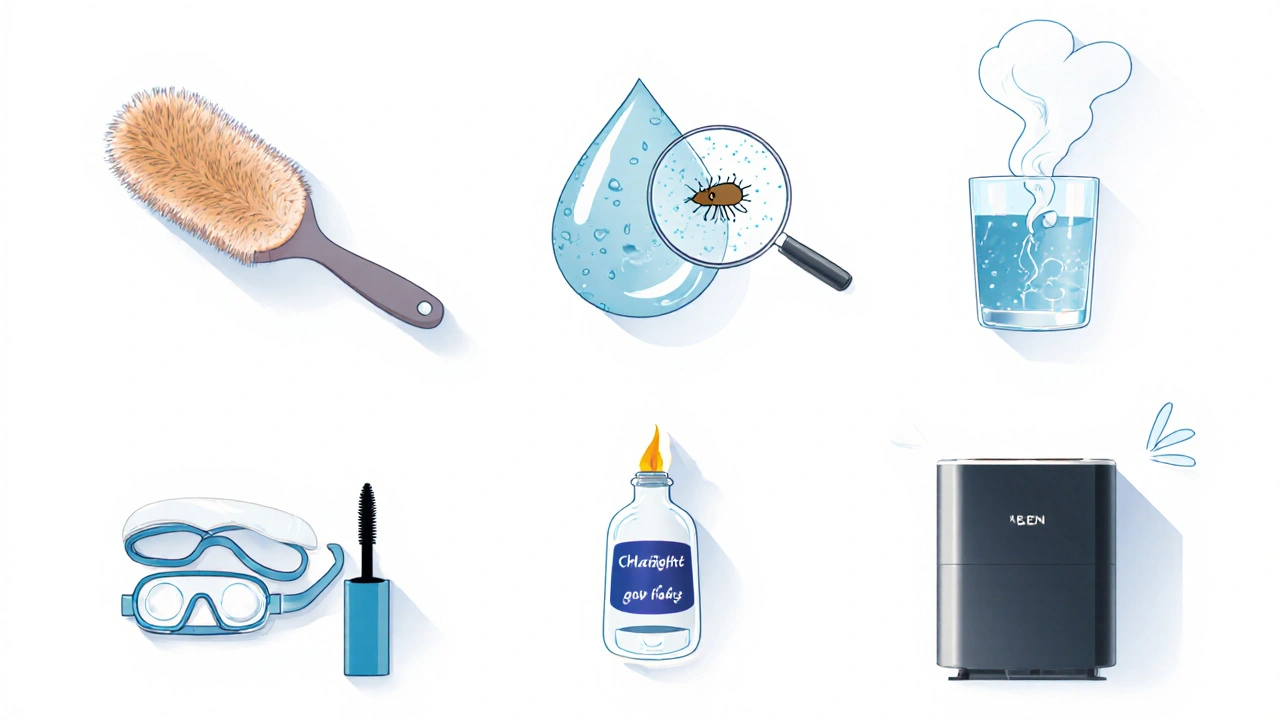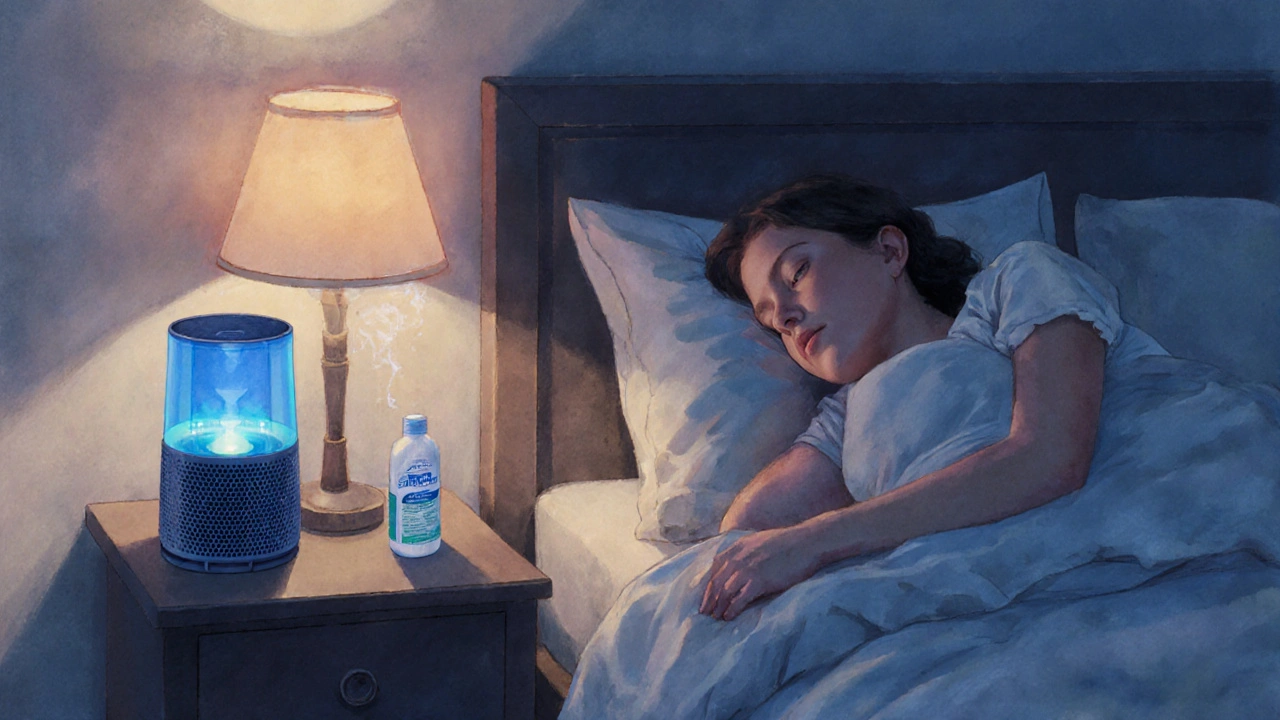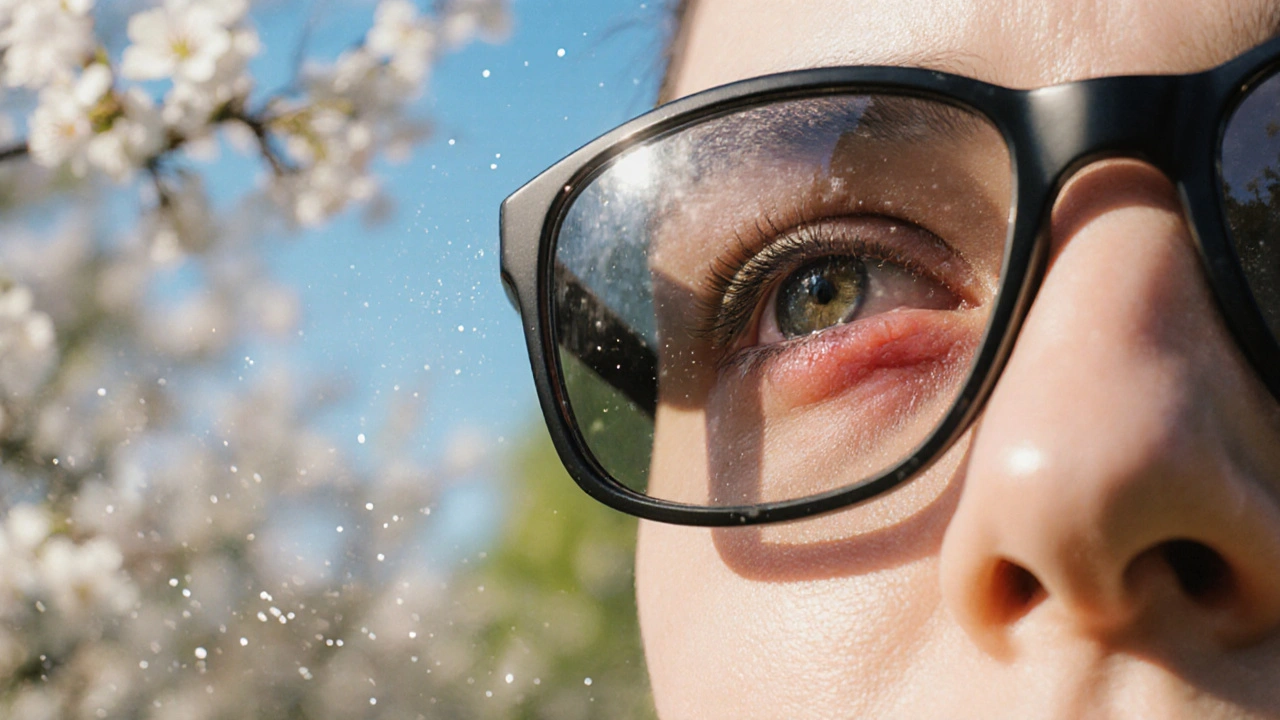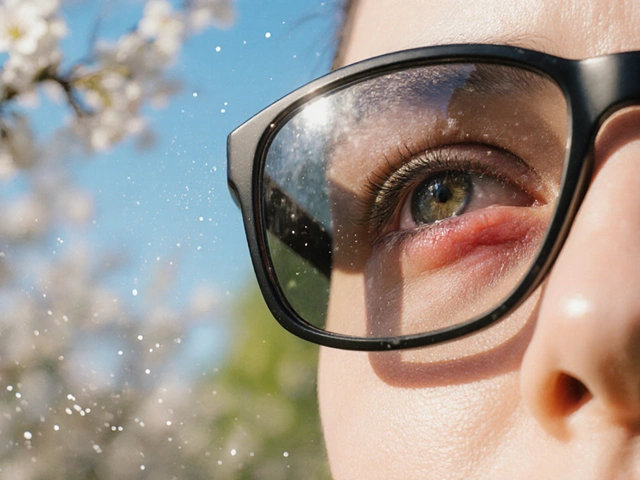Allergic Conjunctivitis Trigger Identifier
Pollen
Fine powder released by trees, grasses, and weeds during flowering periods. Peaks in spring and early fall.
Avoid outdoor exposure on high pollen days. Wear wrap-around sunglasses outdoors.
Pet Dander
Tiny, protein-rich flakes shed from animal skin, saliva, or urine. Cats are a prime source.
Bathe pets weekly, keep them out of bedrooms, and use HEPA vacuum cleaners.
Dust Mites
Microscopic arthropods thriving in warm, humid bedding and upholstery. Their waste proteins are potent allergens.
Wash bedding weekly in hot water (≥60°C), use allergen-impermeable covers, and maintain indoor humidity below 50%.
Mold Spores
Reproductive particles from fungi growing on damp surfaces. Basements and bathrooms are usual hotspots.
Fix leaks promptly, use exhaust fans, run a dehumidifier, and clean visible mold with bleach solution.
Smoke
Includes cigarette, wood-burning, and pollution particles that irritate the conjunctiva. Second-hand smoke can also trigger reactions.
Avoid smoking indoors, ask guests not to smoke, and use air purifiers with activated carbon filters.
Chemicals
Chlorine in pools, hairspray, cleaning agents, and airborne pollutants. Can strip the eye’s protective tear film.
Rinse eyes with sterile saline after swimming, wear goggles in pools, and choose fragrance-free cleaning products.
Eye Makeup
Mascara, eyeliner, and eye shadow that may contain preservatives or fragrances. Expired products often cause flare-ups.
Discard makeup older than six months, opt for hypoallergenic brands, and remove cosmetics before bed.
Contact Lenses
Medical devices placed on the cornea. Improper cleaning or worn-out lenses can harbor allergens.
Follow replacement schedules, clean lenses with approved solutions, and avoid sleeping in lenses unless approved.
Personalized Prevention Plan
Identify which triggers affect you most. Keep a symptom diary to track patterns. Combine avoidance techniques with over-the-counter relief options when needed.
Tip: If symptoms persist beyond two weeks, consult an eye-care professional for further evaluation and treatment.
When you hear Allergic conjunctivitis is an inflammation of the eye’s conjunctiva caused by an allergic reaction to airborne or contact allergens, you probably picture itchy, red eyes that just won’t quit. In reality, a handful of everyday culprits - pollen, pet dander, dust mites, mold spores, smoke, harsh chemicals, eye makeup, and even certain contact lenses - can spark the same irritation. Knowing the main allergic conjunctivitis triggers and how to dodge them turns a chronic nuisance into a preventable annoyance.
Quick Takeaways
- Identify the top five allergens for your environment and keep a symptom diary.
- Use HEPA filters, wash bedding weekly, and maintain low indoor humidity to curb dust mites and mold.
- Limit outdoor exposure on high pollen days; wear wrap‑around sunglasses.
- Choose fragrance‑free cosmetics and replace worn‑out contact lenses regularly.
- See an eye‑care professional if symptoms persist beyond two weeks of self‑care.
What Exactly Is Allergic Conjunctivitis?
The condition falls under the broader category of ocular allergies. It occurs when the immune system releases histamine and other chemicals after encountering an allergen, leading to redness, itching, tearing, and a gritty feeling. While it’s not sight‑threatening, the constant discomfort can affect work productivity and sleep quality.
Major Triggers and How to Spot Them
Below are the common offenders, each introduced with a short definition wrapped in schema markup.
- Pollen is fine powder released by trees, grasses, and weeds during their flowering periods. It spikes in spring and early fall.
- Pet dander refers to tiny, protein‑rich flakes shed from animal skin, saliva, or urine. Cats are a prime source, but dogs, birds, and rodents can also contribute.
- Dust mites are microscopic arthropods that thrive in warm, humid bedding and upholstery. Their waste proteins are potent allergens.
- Mold spores are reproductive particles produced by fungi growing on damp surfaces. Indoor basements and bathrooms are usual hot spots.
- Smoke includes cigarette, wood‑burning, and pollution particles that irritate the conjunctiva. Even second‑hand smoke can trigger reactions.
- Chemicals encompass chlorine in pools, hairspray, cleaning agents, and airborne pollutants. They can strip the eye’s protective tear film.
- Eye makeup consists of mascara, eyeliner, and eye shadow that may contain preservatives or fragrances. Expired products often cause flare‑ups.
- Contact lenses are medical devices placed on the cornea; improper cleaning or worn‑out lenses can harbor allergens.

Practical Ways to Dodge Each Trigger
| Trigger | Avoidance Strategy |
|---|---|
| Pollen | Check local pollen counts, keep windows closed on high‑count days, use air‑conditioned indoor spaces, and wear wrap‑around sunglasses outdoors. |
| Pet dander | Bathe pets weekly, keep them out of the bedroom, use HEPA vacuum cleaners, and consider hypoallergenic breeds. |
| Dust mites | Wash bedding in hot water (≥60°C) weekly, use allergen‑impermeable pillow and mattress covers, and maintain indoor humidity below 50%. |
| Mold spores | Fix leaks promptly, use exhaust fans in bathrooms, run a dehumidifier, and clean visible mold with a diluted bleach solution. |
| Smoke | Avoid smoking indoors, ask guests not to smoke, and use air purifiers with activated carbon filters. |
| Chemicals | Rinse eyes with sterile saline after swimming, wear goggles in pools, and choose fragrance‑free cleaning products. |
| Eye makeup | Discard makeup older than six months, opt for hypoallergenic brands, and remove cosmetics before bed with a gentle cleanser. |
| Contact lenses | Follow the recommended replacement schedule, clean lenses with approved solutions, and avoid sleeping in lenses unless approved. |
Everyday Lifestyle Tweaks That Help
- Air quality control: Pair a HEPA filter with a regular HVAC maintenance schedule. It captures pollen, dander, and dust mite fragments before they settle.
- Hydration: Keep the tear film stable by drinking at least 1.5L of water daily and using preservative‑free artificial tears when eyes feel dry.
- Seasonal planning: If you know you’re pollen‑sensitive, schedule outdoor activities for mid‑morning or late afternoon when counts dip.
- Clothing choices: Change clothes and shower after gardening, mowing, or any activity that stirs up allergens.
When to Seek Professional Care
If symptoms linger more than two weeks despite avoidance, or if you notice swelling, light sensitivity, or vision changes, book an appointment with an optometrist or ophthalmologist. They can confirm the diagnosis with a slit‑lamp exam and may prescribe prescription‑strength antihistamine drops, mast‑cell stabilizers, or short‑course oral antihistamines.
Over‑the‑Counter Relief Options
For mild flare‑ups, look for products that contain ketotifen, olopatadine, or azelastine. These agents block histamine release and calm itching. Apply drops as directed-usually one drop per eye twice daily. Remember to avoid touching the bottle tip to your eye to keep contamination at bay.

Frequently Asked Questions
Can seasonal allergies cause eye problems all year round?
Yes. Even off‑season, indoor allergens like dust mites or pet dander can keep the eyes irritated. Managing both outdoor and indoor triggers is key.
Is it safe to use the same eye drops for both eyes?
Generally, yes-most OTC antihistamine drops are formulated for bilateral use. Just make sure the bottle tip stays clean to avoid cross‑contamination.
Do sunglasses really help with pollen?
Wrap‑around styles create a physical barrier that blocks pollen from reaching the conjunctiva, reducing both itching and redness.
Can eye makeup trigger allergic conjunctivitis even if I’m not allergic to the ingredients?
Yes. Preservatives and fragrance additives can irritate the eye surface, especially after a long day of wear. Switching to hypoallergenic, preservative‑free formulas often helps.
Are there any natural remedies that work?
Cold compresses and saline rinses soothe symptoms, but they don’t treat the underlying allergic response. They’re best used alongside antihistamine drops.
How often should I replace my pillowcase to keep dust mites in check?
Ideally every two weeks, and always wash in water that’s at least 60°C (140°F) to kill mites and their allergens.
Is allergic conjunctivitis contagious?
No. It’s an immune response, not an infection, so you can’t pass it to others.


Amy Morris
October 2, 2025 AT 21:06I know how maddening that constant itch can feel, especially when you’re trying to focus on work.
Keeping a symptom diary helps you spot patterns and match them to specific triggers.
For pollen, checking the local forecast and staying indoors during peak hours makes a huge difference.
Swapping out old eye makeup for hypoallergenic brands can cut down on lingering irritants.
And don’t forget to wash your pillowcases every few days; dust‑mite proteins love a warm, damp fabric.
Francesca Roberts
October 4, 2025 AT 14:46Oh great, another list of “must‑do” things that you’ll forget the moment you step outside.
I mean, who has time to wash bedding in 60°C water anyway?
Just buy an air purifier and hope for the best, right?
…oops, typo, but that’s the point – we’re all busy.
Becky Jarboe
October 6, 2025 AT 08:26From an immunologic standpoint, the IgE‑mediated cascade is the primary driver of ocular mast cell degranulation.
Mitigating exposure to aeroallergens reduces the antigenic load and downstream histamine release.
Implementing HEPA filtration inside the HVAC loop attenuates particulate ingress.
Moreover, a low‑humidity environment (<45%) compromises dust‑mite viability, thereby decreasing allergen concentration.
Carl Boel
October 8, 2025 AT 02:06American households have a responsibility to shield family members from preventable irritants.
By sealing windows and installing high‑efficiency filters, we protect our patriots from foreign pollen invasions.
Ignoring these measures is tantamount to neglecting national well‑being.
Shuvam Roy
October 9, 2025 AT 19:46Maintaining optimal indoor air quality is essential for ocular comfort and overall health.
Regularly servicing ventilation systems and employing dehumidifiers can significantly reduce mold spore proliferation.
Should you require further guidance, please feel free to consult a qualified eye‑care professional.
Jane Grimm
October 11, 2025 AT 13:26It is incumbent upon the discerning individual to recognize that ocular irritation is not merely a trivial inconvenience but a manifestation of environmental negligence.
The adoption of hypoallergenic ocular cosmetics, coupled with disciplined laundering protocols, constitutes a laudable prophylactic regimen.
Failure to adhere to such standards may be deemed an affront to ocular decorum.
Nora Russell
October 13, 2025 AT 07:06One must contemplate the epistemological underpinnings of allergen avoidance, lest we succumb to a myopic perception of ocular pathology.
The intersection of environmental engineering and immunological resilience offers fertile ground for scholarly discourse.
Craig Stephenson
October 15, 2025 AT 00:46I’ve found that swapping out old pillows for allergen‑proof ones really cuts down on the sneezing and eye itch.
Also, keeping a spare pair of sunglasses in the car helps when you’re caught out on a high‑pollen day.
Tyler Dean
October 16, 2025 AT 18:26All that water in your eyes is just a conspiracy of the government to keep you compliant.
Susan Rose
October 18, 2025 AT 12:06In many Asian cultures we’ve long used tea‑infused eye compresses to soothe irritation, and they actually work wonders when combined with modern antihistamine drops.
diego suarez
October 20, 2025 AT 05:46Understanding that both indoor and outdoor allergens can coexist helps us approach treatment holistically.
By integrating routine cleaning with mindful outdoor scheduling, we create a balanced environment that respects both comfort and practicality.
Eve Perron
October 21, 2025 AT 23:26Allergic conjunctivitis, though often dismissed as a mere nuisance, can profoundly disrupt daily activities when left unchecked.
The ocular surface, protected by a thin tear film, becomes vulnerable the moment allergens breach this barrier.
Pollen grains, especially those from ragweed, possess aerodynamic properties that allow them to infiltrate even well‑sealed homes.
Dust mites, thriving in the microscopic interstices of mattresses, release enzymatic proteins that act as potent histamine triggers.
Mold spores, proliferating in damp basements, emit mycotoxins that further inflame the conjunctival epithelium.
Pet dander, composed of keratinous flakes, adheres readily to clothing and furniture, perpetuating exposure long after the animal has left the room.
Chemical irritants such as chlorine and industrial solvents strip away the lipid layer of tears, accelerating dryness.
Even seemingly benign eye makeup can harbor preservatives that act as contact allergens, especially when applied near the lash line.
Improper hygiene of contact lenses creates a biofilm where allergens can accumulate unnoticed.
To counter these multifaceted threats, a layered approach is essential, beginning with environmental control.
Installing high‑efficiency particulate air (HEPA) filters captures both pollen and dander while reducing airborne dust.
Maintaining indoor humidity below 50 percent deprives dust mites of the moisture they require to flourish.
Routine laundering of bedding in water above 60 °C eliminates mite populations and their waste proteins.
Employing dehumidifiers in moisture‑prone areas curtails mold growth, and any visible colonies should be eradicated with a diluted bleach solution.
On the personal care front, selecting fragrance‑free, hypoallergenic cosmetics, washing hands before eye contact, and using preservative‑free artificial tears can dramatically lessen symptoms.
Finally, when despite these measures symptoms persist beyond two weeks, seeking evaluation from an optometrist ensures that targeted pharmacotherapy can be instituted promptly.
Josephine Bonaparte
October 23, 2025 AT 17:06Totally feel ya, Amy! I swapped my old contacts for daily disposables and the eye itch vanished overnight.
Also, ditch that cheap eye cream-it’s a hidden irritant.
Meghan Cardwell
October 25, 2025 AT 10:46When you’re battling ocular inflammation, think of your eye as a battlefield; the antihistamine drops are your elite troops, and the HEPA filter is the fortified wall.
stephen henson
October 27, 2025 AT 04:26The combo of a cool breeze and a good pair of sunglasses does the trick 😊
Manno Colburn
October 28, 2025 AT 22:06I gotta tell ya, I've been researchin’ the whole allergen avoidance thing for years and, honestly, it’s like a never ending maze.
You think you’ve sealed the windows but then a gust of wind blows pollen in, and you’re back to square one.
The thing is, people ignore the smallest cracks in the ceiling where mold loves to hide, and that’s where the real trouble starts.
Also, never underestimate the power of a good old‑fashioned air purifier- it’s basically a magic box.
So yeah, stay vigilant, or your eyes will keep screaming for help.
Namrata Thakur
October 30, 2025 AT 15:46Imagine waking up with crystal‑clear eyes, ready to take on the day- that’s the reality when you master these simple avoidance tricks!
Chloe Ingham
November 1, 2025 AT 09:26They don’t want you to know that the same companies pumping chemicals into the air are also selling “all‑natural” eye drops that barely work.
Mildred Farfán
November 3, 2025 AT 03:06Wow, Carl, thanks for the patriotic pep talk- I’ll definitely install a filter that’s as ‘American’ as my morning coffee.